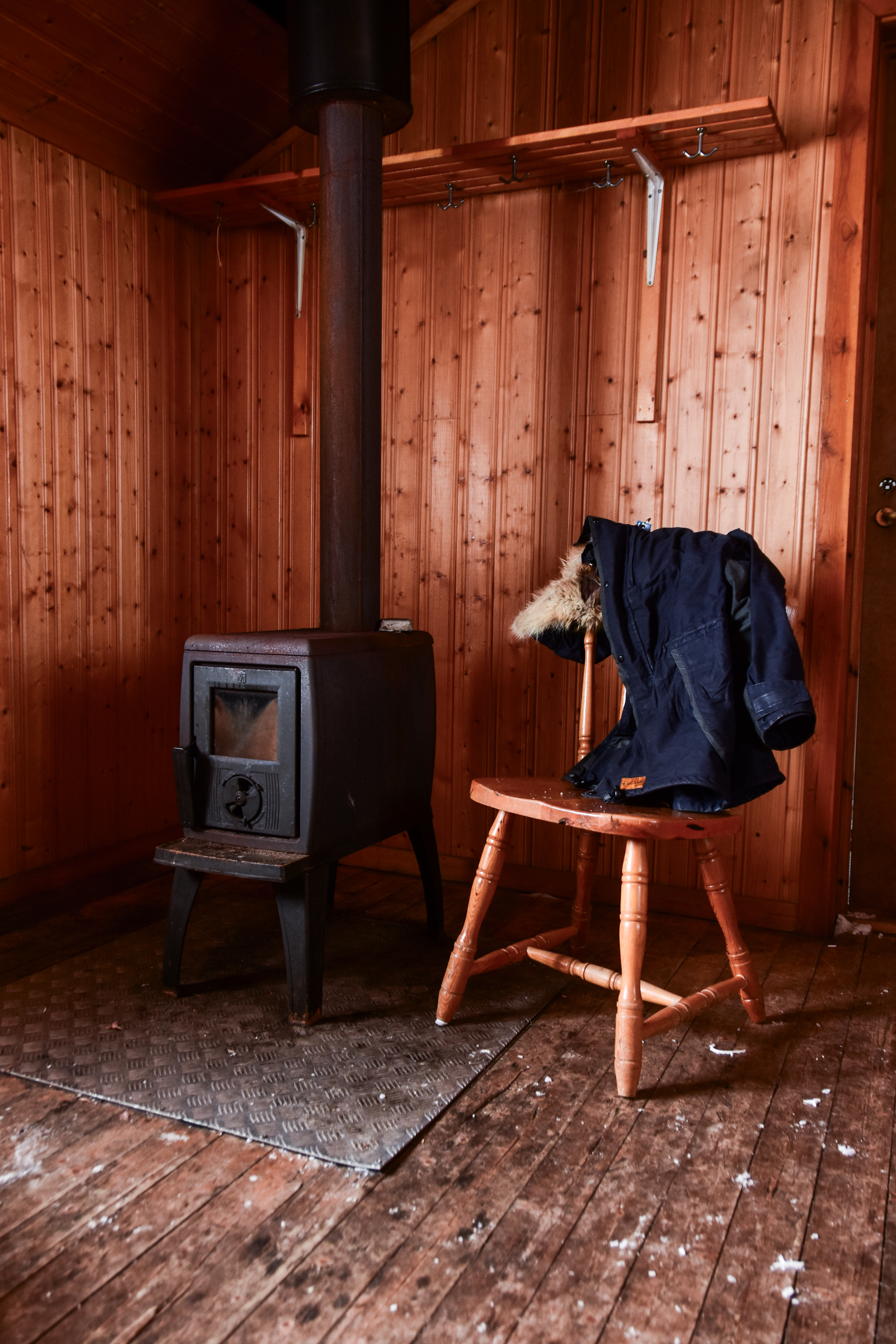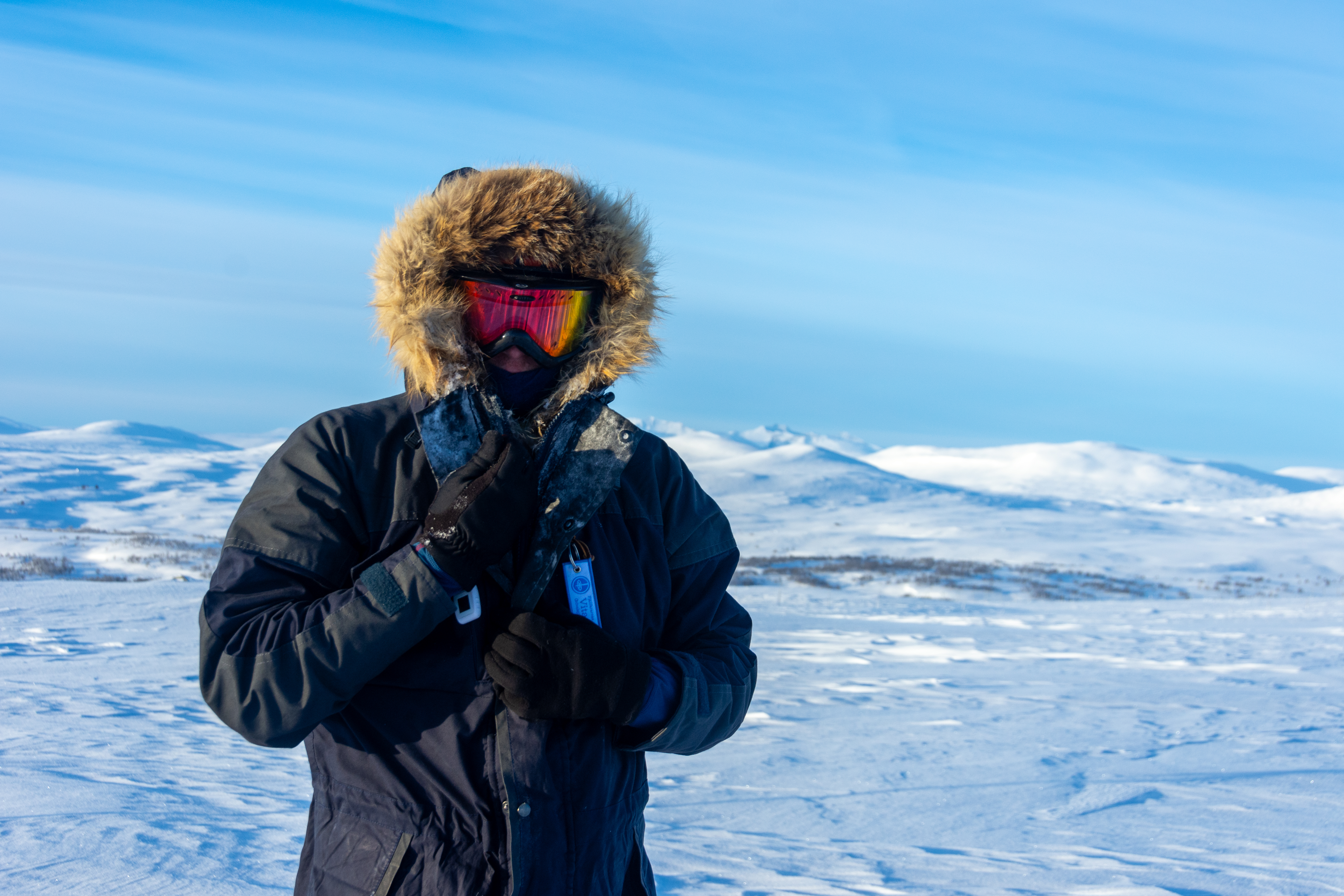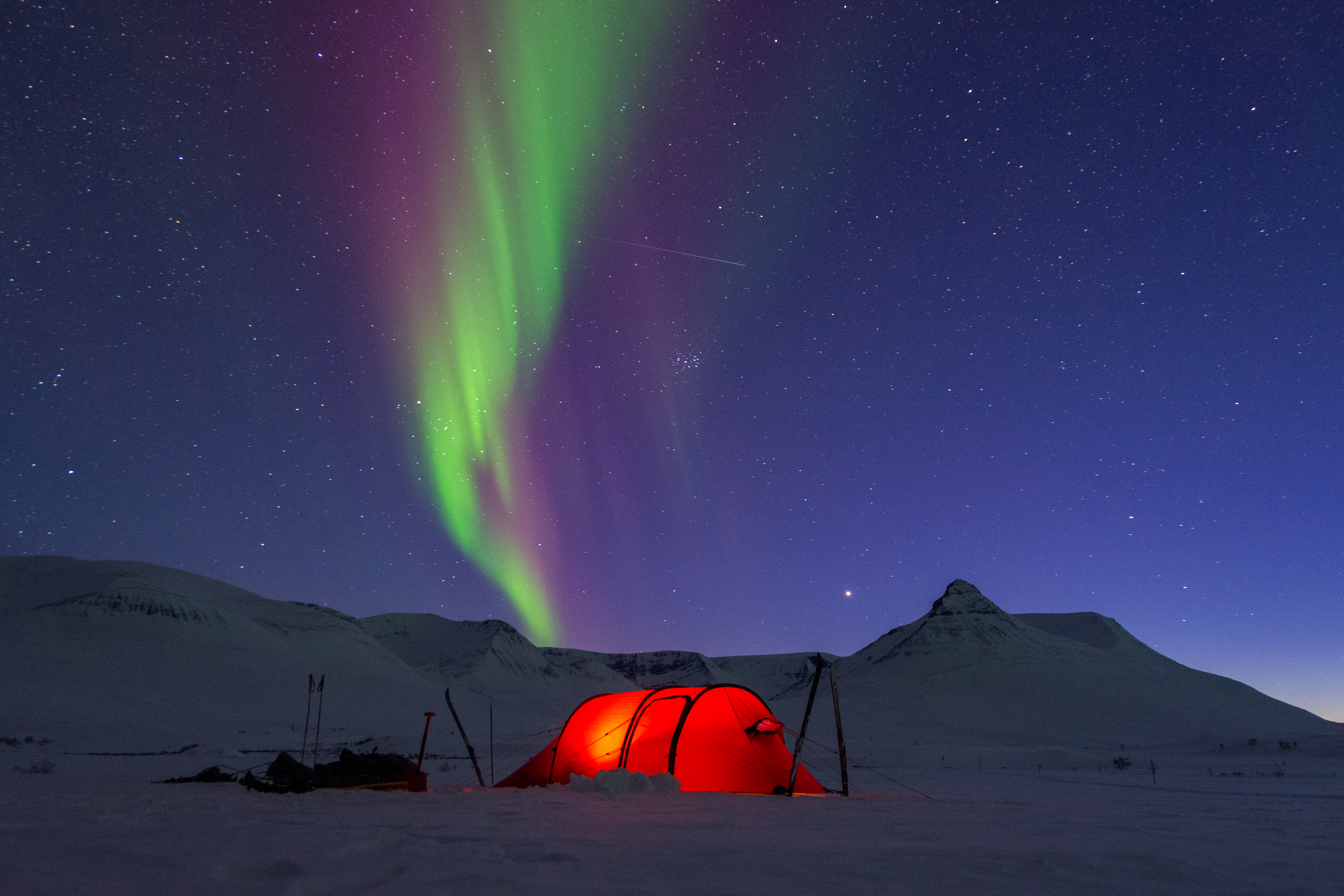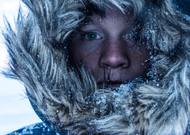Along the Spine of Sweden
Posted by Elijah Ourth on 28th Apr 2024
A 1350 km ski trip along the length of the Swedish mountain chain
The wind whips bitterly across the frozen plateau. Up here above the treeline there is nothing to stop it for miles as it comes across from the west from the Norwegian mountains and spills over the mountains here. I zip my jacket up all the way and bury my head in the hood. I feel extremely glad to be sheltered and warm inside my Askival Cotton Analogy® Jacket.
I recently completed a 1350km ski traverse of the Swedish mountain chain. A trip that took 76 days and took me from Grövelsjön in the south to Treriksröset, or the three-country cairn in the north. The northernmost point in Sweden. For the past nearly 3 months I have been living in my Askival jacket and have loved it. It has been the first thing I put on when I get out of the tent in the morning, and the last thing I take off at night. Even then, I drape it over the foot of my sleeping bag to keep condensation from the tent from touching the foot of my bag.
I left from Grövelsjön the 13 of January, right in the dead of winter. My girlfriend Sofia, who would follow along for the first four days, and I, took the bus from our home in Östersund, down to Grövelsjön the night before. We stayed the night at the mountain cabin, preparing the last little things that always need to be done before a big trip. Repacking food, tying on attachments on the pulk, and just generally making sure you have everything. In the morning, we ate a big breakfast and then waited for first light to head out. The first day, as we headed towards Rogen nature reserve, we had blue skis and beautiful weather, if a bit chilly, and we practically danced forward with excitement and joy. For the next 4 days we made our way north across the large lakes and low mountains of Rogen and Grövelsjön to Tänndalen. This early in the season, we had the area to ourselves, with fresh powder and untracked snow. Here we were met by an incredibly kind couple who welcomed us into their home and gave us cinnamon buns, warm food and a place to dry off, before Sofia headed back home. While the trip was largely alone, one of the best parts were the people I sometimes got to meet. Throughout the entire trip, I was constantly surprised by how incredibly kind people are to a tired and stinky skier. I was constantly offered food and coffee and kind conversation around a cabin fireplace.
For the first 2 weeks of the trip, the temperature seldom climbed over -20 degrees Celsius and a few days on the trip I even got to experience temperatures of nearly -40. When the temperature is this cold, it feels as if the whole world has frozen solid. As if you are skiing through a silent photograph frozen in place, where you are the only thing moving through the frame. Your senses become so aware, and you feel every breath in your nose and every tiny puff of wind on your cheeks. An incredible feeling.
On a trip like this, every piece of equipment and every gram carried must carefully be considered, and after a long time I settled on a Hilltrek Cotton Analogy® Askival jacket, and I couldn’t have been happier about my choice.
The highlight of this jacket is of course the Ventile® material. Swedish winters can be incredibly variable, unfortunately even more so due to climate change, with temperatures below -35 common, but also with rain in February and I wanted something that would protect me from the whole spectrum. I found the Ventile® to be incredibly breathable, even working hard pulling the pulk up steep hills. The only weakness is in very wet snow where the cotton seemed to gather more snow than a synthetic outerlayer does. However, it was still extremely weatherproof and I was able to use the same clothing system of just a baselayer and the jacket, for skiing, for nearly the entire trip. If it was very cold and windy, I could easily throw on a light fleece underneath the jacket, and on really warm days the full zipper of the jacket allowed me to open it up entirely to shed a lot more warmth. While anoraks can be nice for winter trips, with the huge pocket, I have found that for me, jackets work better, and I really liked having the full zip on the Askival to be able to vent heat better, access pockets on a midlayer, and just for the ease of getting it on and off.
It's a huge sense of security to have the Askival, knowing it would protect me from the worst of storms.

Here going over the large lakes of Rogen Nature Reserve.
One thing to note about the double layer lining system that this jacket has is that sometimes after several days of very cold temperatures (-25 Celsius or so: much warmer and it wasn’t really a problem) I noticed a layer of ice forming between the two layers where there wasn’t enough heat to fully evaporate it from the jacket. With the liner, it was quite nice that this was keeping the ice and moisture off my body and base layer, but it did mean that you couldn’t scrape and brush it off at the end of the day like you can with a single layer jacket.
As the trip went on, the temperature got warmer, and the days got longer and longer.
It was a kind of cool feeling to start so early in the winter, as it meant I got to experience the full change of seasons throughout the trip, from the cold and dark winters in the beginning where several hours a day were spent skiing by the light of my headlamp, to the spring winter weather towards the end of the trip. I think that is what I like best about a trip like this is being able to be out long enough that your days and your mindset thoroughly change, and you become more aware and part of nature. Where the normal actions of being on expedition become your constant: something you are privileged enough to experience every day. From waking up and eating oatmeal in the sleeping bag, to skiing all day long. While your body is working hard, your mind gets to rest in a way like no other when all you must do is break camp, ski, and set up camp, and the biggest decisions you must make are if you want pesto pasta for dinner, or mashed potatoes. It becomes such a simple life, going back to the basics.

Cozy cabins for a break or emergencies.
Throughout the trip, there are a few cabins spread throughout the mountains that are open for skiers to be able to take a quick break and eat lunch, or to spend the night in emergency situations. Very cozy to be able to come out of the howling wind for a few minutes before continuing on.
Of course, being out all winter long, I got to experience all possible sorts of weather. About a third of the way through the trip, I made my way up and over the Hottagsfjället mountains. The weather in the mountains can change quick, and I went to sleep to a calm windless night, only to wake a few hours later to gale force winds and one of the windiest storms I have seen in the mountains. I spent the night just hoping the tent poles would hold, constantly going up to recheck the tent and re tension guylines, until morning came and I was able to break camp and continue. Through the night on my hourly checks, and in the morning, I was incredibly glad for the full protection and sense of security my Askival gave me. As I made my way north, the storm, Ingunn, ended up setting new wind records in Sweden, with speeds of over 58 m/s or over 200 km/h. But as time went on the weather calmed again and I was treated to magical sunsets and sunrises. I love the winter light that the northern latitudes provide. This time of year, when the days are short, the sunrises and sunsets seem to last forever. Long before the sun comes up, the sky is bathed in a purple blue glow, slowly turning to pinks and reds and yellows turning more and more vivid until the sun comes up. Sometimes it rises fast with an astounding moment where you immediately turn your face towards the sun and soak in the first rays of the day. And sometimes it seems as if it is just there without rising at all. Suddenly you notice that the pastel light show is over and suddenly it’s bright outside and the day has begun. And then come afternoon, the same thing happens all over again in reverse, with the sunset tones slowly giving way to twilight and then starlight over the tent.
As I made my way up above the arctic circle, the mountains got more and more impressive. My favourite part of the trip was going through Sarek National Park.

Fresh tracks through Sarek National Park
I had intended to take the Kungsleden, but when I skied out on Lájtávrre, and the Rapadalen valley opened up in front of me, I couldn't resist going through Sarek. It had been minus 17 degrees during the night and all the mountain birches were completely covered in hoarfrost and glistening in the sun. The morning fog hadn’t completely lifted so it was as if the mountains had stripes of clouds. Heading into Sarek, on one side you have Skierffe, which is like a black shark's fin that rises above the valley, and on the other side, Tjaikelij is just as majestic, and then far ahead, alone in the valley, Nammásj stands completely by itself. It was as if my skis chose for themselves to turn into Rapadalen and then up towards Ähpár and Basstavágge. It was a luxury to have a trip like this and be able to just follow where the snow and nature’s lines lead me, and wherever I next wanted to go, while still making my way up towards Treriksröset.

The last week traveling through a world of white.
The Askival ended up being the perfect jacket on this trip. Of course, there are a few things I wish were different about the jacket. My largest complaint was that the sleeves were a little short. Now while they weren’t necessarily too short in the normal sense, they fit right to the wrist, on a jacket like this where the overall fit is slightly oversized for winter use, I would have expected the sleeve length to also be a bit long. It made it hard to fit the sleeves over gloves or mittens, and immediately when starting skiing they would fall off the glove cuff leaving the wrist exposed. Hilltrek does offer custom sleeve length, so this shouldn’t be a big problem, but all other jackets of this style I have had, have a long sleeve in order to fit over gloves, and so I would encourage everyone planning to use it in winter to order long sleeves, or for the standard sleeve length to be made longer. Other than this however, the fit of the jacket was perfect! It was the perfect size to be able to fit layers underneath, while not being too baggy, and the length of the jacket was great to provide some extra warmth for thighs, or while sitting down.
Another thing I might change would be to make the chest pockets slightly larger, perhaps even bellowed. With a pulk harness or a backpack hip belt on, the hand pockets become inaccessible, and so I found myself very reliant on the chest pockets. They needed to hold everything from extra liner gloves, snacks for the day, ski wax, satellite messenger, and often even a headlamp and other extras.
One of the best things about the jacket was the hood. The hood fit perfectly and was large enough to fit over hats and give room for movement but was also able to be cinched down in strong headwinds. Note however that I did sew on a fur ruff to the hood. While I think fur ruffs are seldom necessary for most use, in a polar environment like this it does make a huge difference, creating a pocket of warm air close to the face, blocking the wind, and making breathing easier on bitterly cold days. After much searching, I found a used coyote fur ruff that fit the hood perfectly and sewed it to the inside of the hood. The only change to the hood I might make is a one-handed adjustment system, especially for the volume adjuster on the back.

The hood on the Askival was one of my favourite features. As soon as I put it on I felt immediately warm and protected from even the worst headwinds.
Another one of the things I really appreciated about the jacket is how the cinches around the waist, hem, and hood were a rope instead of a bungee. I think it holds much more securely, and I have had bungees on jackets previously get stretched out easily, so this solution seems a lot more durable.
The snaps on the jacket are also some of the best I have ever used. They hold extremely strongly, instead of popping open when you bend over. This made it an easy solution for venting the jacket in different ways, or just a quick way to close it up, which with the double flap kept the wind out very well.
All in all, this was without a doubt the perfect jacket for a trip like this. It’s crazy how reliant in your equipment you become, and it provided a sense of security to know that I had clothing that could protect me in whatever I might encounter.
Finally, on the 29 of March, I reached my goal at the northernmost point of Sweden. It had taken my 76 days and nearly 1400 kilometers. And while part of me wants to say it was the adventure of a lifetime, I really hope it isn’t. I hope that I will get to experience a trip like this, and the joy that I felt while being out there, many times again. And if I do, I’m sure I will be wearing my Askival.

My last campsite by Pältsa before reaching the three country cairn I was treated to some of the most fantastic Northern lights over my tent and the surrounding mountains.
It truly felt like a great way to end the trip
Now that I am back home, I have been thinking a lot about how when I was out on the trip, people often said that “oh it must be so exciting to get to Treriksröset, to cross the finish line! It will feel so good!” And sure, I was happy, and it did feel good as we stood there and toasted with the juice Sofia had brought out to celebrate. But most of all it felt sad. It felt sad that it was over. It’s like reading the last sentence of a really good book. You know you can read it again, but you can never read it again for the first time. I was going to miss being out in the mountains. Miss my 10 break with a thermos of coffee and a roll of cookies and nothing to do but watch the wind and snow blow past.
Something about this jacket reminds me of this. It’s not like a modern synthetic in bright colors that blends into the modern life of man-made things, convenience, and that not of nature. But rather hanging on the hook in my house it reminds me of the timelessness of my trip. That no matter how long it takes, when I’m able to go on another long tour it will be there waiting, same as it always has been.
But then, as I write, I hear my phone chime and look at the notification. A text from my friend. “Any interest in one last spring skiing trip this weekend?” I start quickly packing my stuff, throwing everything into its well-known place in my pulk. After this long it’s as if every piece of equipment has its exact place in the sled. I throw everything together and pull the pulk out the door. And of course, as I pass the hook on my way out, I throw on my Askival. It’s always ready for one more adventure big or small, near to home or far away. It's ready to be worn in its proper place, out in nature.
Analogy® -Trade Mark Registered to Nikwax Ltd
Ventile® -Trade Mark Registered to Stotz Ag









